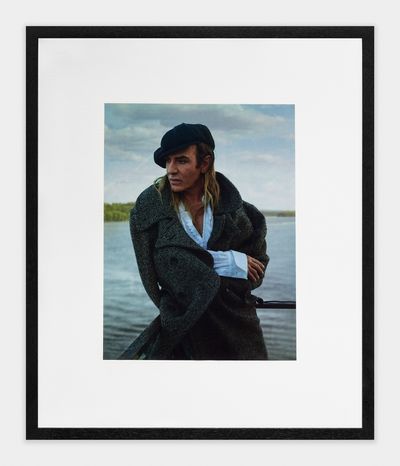Armed InterpretationDavid Lieske
–Press release
VI, VII is pleased to announce “Armed Interpretation,” an exhibition of new works by German artist David Lieske on view at Operagata 75A from January 25-April 6, 2024. This is the artist’s fourth solo exhibition with the gallery. A public reception will be held on Thursday, January 25, from 6-8pm.
At the center of David Lieske’s exhibition at VI, VII Oslo is the photographic reproduction of the German machine gun type 08/15. First developed in 1908 and improved in 1915, the automatic gun was the weapon of choice of the German Army during the First World War. A derivate of American inventor’s Hiram Maxim’s “classic” machine gun, which was at the time of its invention advertised as “The World’s Standard”, the name 08/15 entered German colloquial use as a description of something that is so standard that it is dull. [1]
The MG 08/15 is indeed also the origin of another notoriously German institution: The DIN-standard, which was first applied in 1918 to a machine part of the gun, subsequently issued industrial norms for all kinds of objects, ranging from paper sizes to table heights (according to the German Institute for Standardisation, there are over 33.500 DIN-standards today), thereby brilliantly illustrating the somewhat clichéd notion of a German post-war civil society that, albeit no longer beset by the death drive of its past militarist ambitions, yet filled to the brim with military values and their norms. In “Armed Interpretation”, Lieske traces the symbolic transformation of a killing machine to the societal automation of boredom.
The artist’s interest in the machine gun 08/15, the “standard of the 20th century” [2] as Peter Berz has called it, was sparked by an image file he found in the collection of the Imperial War Museum in London. This particular gun had been captured by British troops in 1918 and donated to the collection of the museum, from where Lieske takes it to Oslo in an act of what he calls an “export of German mediocrity”. Lieske’s photographic reproduction of the gun, for which he employed an image-generating Artificial Intelligence to add interpretative depth, is divided into six individual panels, each of which is sized in a different DIN-standard for paper. They are attached to a free-standing wall that is propped up and weighted with sand bags reminiscent of a trench. Part sculpture, part exhibition architecture, the wall is sized 336 × 237,6 cm, a fictitious format DIN--3 (“DIN negative three”), which Lieske designed specifically for the exhibition.
French epistemologist Georges Canghuilhem has emphasized how historically, the standardization of weapon parts that was first introduced by Napoleon Bonaparte as an answer to logistical problems of military supply, acted on the same collective demand as Richelieu’s reform of French grammar in the 17th century, and as the subsequent reforms of hospitals, factories and schools, which were in effect reforms of “normalization”. [3]
One could say that – at least since the French Revolution – the school is defined as the place were a democratic subject is to learn and accept societal norms or to work around them. With the implementation of the normal, the misfit is born. Lieske draws on this narrative tradition when he retells his coming of age in a wealthy Hamburg suburb in the 1990s. Recalling high-brow field recordings and natural history documentaries, his recollections of youthful ennui and affection are played in the AI-generated voice of David Attenborough from a vintage tape recorder that is placed adjacent to the MG-08/15 wall-piece. An avid reader of Bourdieu, the artist recounts the mechanisms by which a boy learns to glean his own variant of subjecthood from the standardized features that are available to him in terms of class, sexuality and political conviction within a consumerist mainstream, whose authoritarian tendencies and casual racism are lingering under a thin varnish made up of brightly colored windbreakers and neat Lacoste-sportswear. The unbearable boredom of school and a privileged upbringing ignite the boy’s appetite for militant upheaval. Amid one of Hamburg’s famous street riots of the 1990s between representatives of the state and the militant Black Block wing of the antifa, he finds his calling. When a husky German police man in full riot gear grabs young Lieske by his scratchy woolen scarf and lifts him off the ground, all the aesthetic predilections, erotic fantasies and traumatic undercurrents of his West German boyhood are suddenly merged together as meaningful parts in a perfect aggregate.
- Nina Franz
[1] Nullachtfünfzehn
[2] Peter Berz: 08/15. Ein Standard des 20. Jahrhunderts. Wilhelm Fink Verlag, München, 2001.
[3] “Like pedagogical reform, hospital reform expresses a demand for rationalization which also appears in politics, as it appears in the economy, under the effect of nascent industrial mechanization, and which finally ends up in what has since been called normalization.” Georges Canghuilhem: The Normal and the Pathological. Translated by Carolyn R. Fawcett and Robert S. Cohen, p. 238 and 245.
ARTIST BIOGRAPHY
Emerging onto the German art scene with his inclusion in the exhibition “Formalismus. Moderne Kunst, heute” curated by Yilmaz Dziewior at Hamburg Kunstverein in 2004, David Lieske made his institutional debut at the tender age of twenty-four. Since then his work has explored connections between social and historical circumstances with power, personal desire and identity through image-making, sculpture and conceptual photo-based works.
Throughout, he has initiated of a wide variety of projects that have allowed him to live other lives and wear other hats as a DJ, musician, gallerist, editor and designer: co-founding Hamburg based DIAL records in 1999 and Berlin/New York based Mathew Gallery from 2012-2018. Other collaborations include visual art and music made with Rob Kulisek presented under the name Kulisek/Lieske, the fashion magazine 299 792 458 M/S (also with Kulisek), published by Westreich Wagner, and the tennis fashion label DL Courtwear.
In 2015, a solo exhibition at MUMOK Vienna centered around Lieske’s biography addressed the fluid borders between life and work that has been so relevant to, and embedded within his practice over time.
Born in Hamburg in 1979, the artist now lives and works in London.
Solo exhibitions include: Platoon (RL-X), Mumok, Vienna; Platitude Normale, CAPC Musée d’Art Contemporain de Bordeaux; Style and Subversion 1979-2012, Corvi-Mora, London; A Greater Administration of Lower Interests, Tobias Naehring, Leipzig; Imperium in Imperio, Alex Zachary, New York; New Work, Midway Contemporary Art, Minneapolis; Atlantis, Galerie Daniel Buchholz, Cologne; Everything that doesn’t happen today doesn’t happen, Galerie Daniel Buchholz, Berlin.
Notable group exhibitions include: Jahresgaben, Kunstverein in Hamburg, No Dandy, No Fun, Kunsthalle Bern; Magazine, Kunstverein in Hamburg; The Secret Life of Objects, Midway Contemporary Art, Minneapolis; More Carpets, Bortolozzi, Berlin; Quodlibet II, Daniel Buchholz, Cologne; Whole Lotta Love, Contemporary Fine Arts, Berlin; This is Not a Void, Galeria Luisa Strina, Sao Paulo; Teil 2, Quodlibet, Galerie Daniel Buchholz, Cologne; Formalismus. Moderne Kunst, heute, Kunstverein in Hamburg.
David Lieske’s works are in the esteemed collections of MCA, Chicago, the Boros collection, the Haubrok Foundation and Mumok, Vienna.
Armed Interpretation

Armed Interpretation
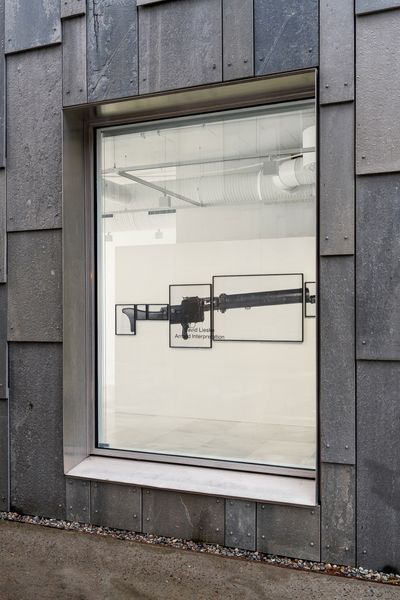
Armed Interpretation
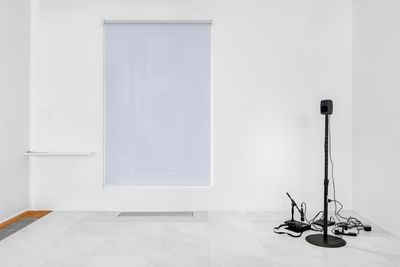
David Lieske, “Armed Interpretation” (Preface, Chapter I-VI), 2024
Marantz PMD222 Cassette recorder, Cassette Tape, Microphone, Microphone stand, Mixing console, Cables, Genelec Speaker, Speaker stand
Marantz PMD222 Cassette recorder, Cassette Tape, Microphone, Microphone stand, Mixing console, Cables, Genelec Speaker, Speaker stand
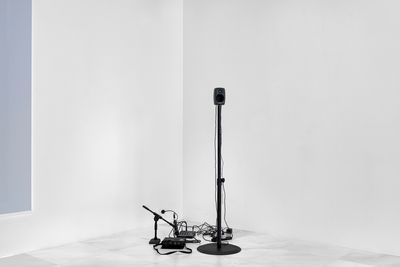

David Lieske, “Armed Interpretation” (Preface, Chapter I-VI), 2024
Marantz PMD222 Cassette recorder, Cassette Tape, Microphone, Microphone stand, Mixing console, Cables, Genelec Speaker, Speaker stand
Marantz PMD222 Cassette recorder, Cassette Tape, Microphone, Microphone stand, Mixing console, Cables, Genelec Speaker, Speaker stand
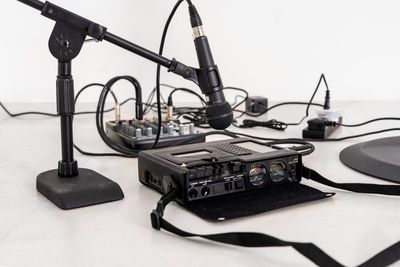

Armed Interpretation
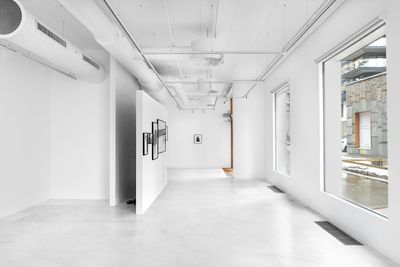
David Lieske, “Armed Interpretation” (DIN A -3), 2024
MDF, acrylic paint, wooden beams, steel and sand bags
237.6 × 336 × 12.3 cm (93 ½ × 132 ¼ × 4 ⅞ inches)
MDF, acrylic paint, wooden beams, steel and sand bags
237.6 × 336 × 12.3 cm (93 ½ × 132 ¼ × 4 ⅞ inches)


Armed Interpretation
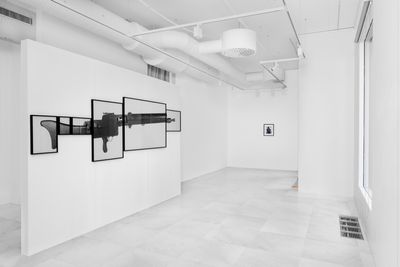
David Lieske, “Armed Interpretation” (08/15) I-VI (I), 2024
Inkjet print on Hahnemühle PhotoRag Ultrasmooth, framed Overall: 96 × 331.4 × 3 cm (37 3/4 × 130 1/2 × 1 1/8 inches) DIN A3 43.6 × 31.3 cm (17 1/8 × 12 3/8 inches) DIN A6 22.6 × 16.4 cm (8 7/8 × 6 1/2 inches) DIN A4 22.6 × 31.3 cm (8 7/8 × 12 3/8 inches) DIN A1 85.6 × 61 cm (33 3/4 × 24 inches) DIN A0 85.6 × 120.4 cm (33 3/4 × 47 3/8 inches) DIN A2 43.6 × 61 cm (17 1/8 × 24 inches)
Inkjet print on Hahnemühle PhotoRag Ultrasmooth, framed Overall: 96 × 331.4 × 3 cm (37 3/4 × 130 1/2 × 1 1/8 inches) DIN A3 43.6 × 31.3 cm (17 1/8 × 12 3/8 inches) DIN A6 22.6 × 16.4 cm (8 7/8 × 6 1/2 inches) DIN A4 22.6 × 31.3 cm (8 7/8 × 12 3/8 inches) DIN A1 85.6 × 61 cm (33 3/4 × 24 inches) DIN A0 85.6 × 120.4 cm (33 3/4 × 47 3/8 inches) DIN A2 43.6 × 61 cm (17 1/8 × 24 inches)
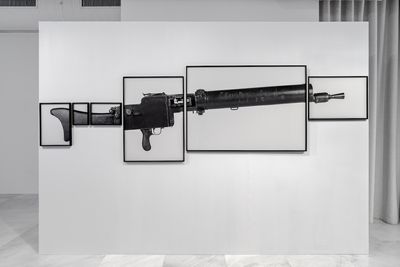

David Lieske, “Armed Interpretation” (08/15) I-VI (I), 2024
Inkjet print on Hahnemühle PhotoRag Ultrasmooth, framed Overall: 96 × 331.4 × 3 cm (37 3/4 × 130 1/2 × 1 1/8 inches) DIN A3 43.6 × 31.3 cm (17 1/8 × 12 3/8 inches) DIN A6 22.6 × 16.4 cm (8 7/8 × 6 1/2 inches) DIN A4 22.6 × 31.3 cm (8 7/8 × 12 3/8 inches) DIN A1 85.6 × 61 cm (33 3/4 × 24 inches) DIN A0 85.6 × 120.4 cm (33 3/4 × 47 3/8 inches) DIN A2 43.6 × 61 cm (17 1/8 × 24 inches)
Inkjet print on Hahnemühle PhotoRag Ultrasmooth, framed Overall: 96 × 331.4 × 3 cm (37 3/4 × 130 1/2 × 1 1/8 inches) DIN A3 43.6 × 31.3 cm (17 1/8 × 12 3/8 inches) DIN A6 22.6 × 16.4 cm (8 7/8 × 6 1/2 inches) DIN A4 22.6 × 31.3 cm (8 7/8 × 12 3/8 inches) DIN A1 85.6 × 61 cm (33 3/4 × 24 inches) DIN A0 85.6 × 120.4 cm (33 3/4 × 47 3/8 inches) DIN A2 43.6 × 61 cm (17 1/8 × 24 inches)
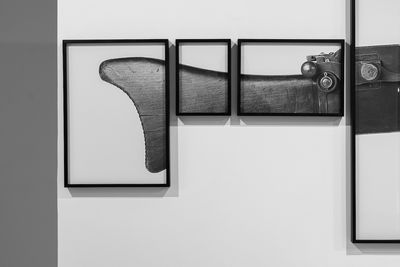

Armed Interpretation
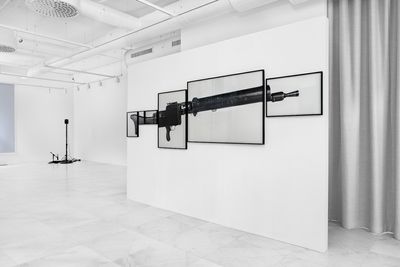
Armed Interpretation
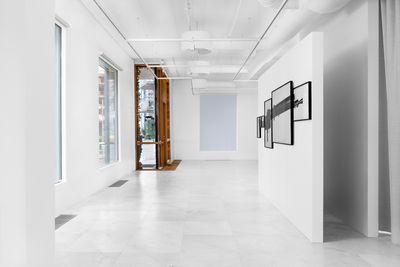
Armed Interpretation

David Lieske
Anti-Anti-, 2022
Magazine page, framed
Vanity Fair, July 2013 Issue, “Galliano in the Wilderness” by Ingrid Sischy, Photography by Annie Leibovitz
42.5 × 35.5 × 3 cm (16 ¾ × 14 × 1 ⅛ inches)
